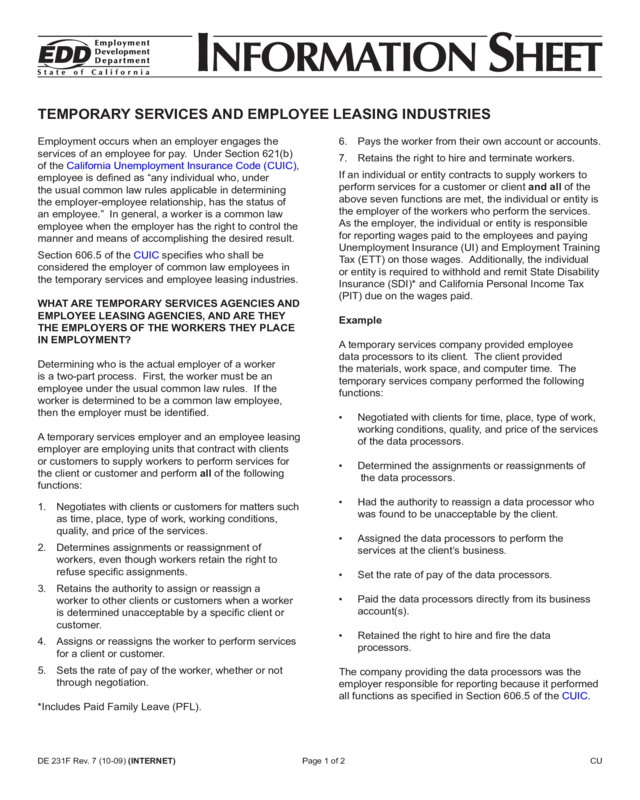Fillable Printable Temporary Services And Employee Leasing Industries (De 231F)
Fillable Printable Temporary Services And Employee Leasing Industries (De 231F)

Temporary Services And Employee Leasing Industries (De 231F)

6. Pays the worker from their own account or accounts.
7. Retains the right to hire and terminate workers.
If an individual or entity contracts to supply workers to
perform services for a customer or client and all of the
above seven functions are met, the individual or entity is
the employer of the workers who perform the services.
As the employer, the individual or entity is responsible
for reporting wages paid to the employees and paying
Unemployment Insurance (UI) and Employment Training
Tax (ETT) on those wages. Additionally, the individual
or entity is required to withhold and remit State Disability
Insurance (SDI)* and California Personal Income Tax
(PIT) due on the wages paid.
Example
A temporary services company provided employee
data processors to its client. The client provided
the materials, work space, and computer time. The
temporary services company performed the following
functions:
• Negotiated with clients for time, place, type of work,
working conditions, quality, and price of the services
of the data processors.
• Determined the assignments or reassignments of
the data processors.
• Had the authority to reassign a data processor who
was found to be unacceptable by the client.
• Assigned the data processors to perform the
services at the client’s business.
• Set the rate of pay of the data processors.
• Paid the data processors directly from its business
account(s).
•Retainedtherighttohireandrethedata
processors.
The company providing the data processors was the
employer responsible for reporting because it performed
allfunctionsasspeciedinSection606.5oftheCUIC.
Employment occurs when an employer engages the
services of an employee for pay. Under Section 621(b)
of the California Unemployment Insurance Code (CUIC),
employeeisdenedas“anyindividualwho,under
the usual common law rules applicable in determining
the employer-employee relationship, has the status of
an employee.” In general, a worker is a common law
employee when the employer has the right to control the
manner and means of accomplishing the desired result.
Section606.5oftheCUICspecieswhoshallbe
considered the employer of common law employees in
the temporary services and employee leasing industries.
WHAT ARE TEMPORARYSERVICES AGENCIES AND
EMPLOYEE LEASING AGENCIES, AND ARE THEY
THE EMPLOYERS OF THE WORKERS THEY PLACE
IN EMPLOYMENT?
Determining who is the actual employer of a worker
is a two-part process. First, the worker must be an
employee under the usual common law rules. If the
worker is determined to be a common law employee,
thentheemployermustbeidentied.
A temporary services employer and an employee leasing
employer are employing units that contract with clients
or customers to supply workers to perform services for
the client or customer and perform all of the following
functions:
1. Negotiates with clients or customers for matters such
as time, place, type of work, working conditions,
quality, and price of the services.
2. Determines assignments or reassignment of
workers, even though workers retain the right to
refusespecicassignments.
3. Retains the authority to assign or reassign a
worker to other clients or customers when a worker
isdeterminedunacceptablebyaspecicclientor
customer.
4. Assigns or reassigns the worker to perform services
for a client or customer.
5.Setstherateofpayoftheworker,whetherornot
through negotiation.
*Includes Paid Family Leave (PFL).
TEMPORARY SERVICES AND EMPLOYEE LEASING INDUSTRIES
DE231FRev.7(10-09)(INTERNET)Page 1 of 2 CU

Under What Circumstances Is the Client or Customer
of the Agency the Employer of the Workers?
If an individual or entity who contracts to supply workers
to perform services for a customer or client is not a
leasing employer or temporary services employer (as
described above), the client or customer would be the
employer for UI, ETT, SDI, and PIT purposes. If the
individual or entity contracting to provide the worker pays
the worker, the individual or entity would merely be the
agent of the client or customer and not the employer.
RefertoSection606.5(c)oftheCUIC.
When Employers Loan Employees to Other
Employers, Who Is the Employer of the Loaned
Employees?
In circumstances where an employee is loaned by one
employer to another employer, the loaning employer
remains the employer responsible for UI, ETT, SDI,
and PIT purposes if the loaning employer continues
to pay remuneration to the employee, whether or
not reimbursed by the other employer. However, if
the employer to whom the employee is loaned pays
remuneration directly to the employee for services
performed, that employer shall be considered the
responsible employer for employment tax purposes
for any remuneration paid to the employee by such
employer. This is true regardless of whether the loaning
employer also pays remuneration to the employee.
RefertoSection606.5(d)oftheCUIC.
ADDITIONAL INFORMATION
For further assistance, please contact the Taxpayer
AssistanceCenterat(888)745-3886orvisitthe
nearestEmploymentTaxOfcelistedintheCalifornia
Employer’s Guide (DE 44) or access EDD’s Web site at
www.edd.ca.gov/payroll_taxes/.
EDD is an equal opportunity employer/program.
Auxiliary aids and services are available upon request to
individuals with disabilities. Requests for services, aids,
and/or alternate formats need to be made by calling
(888)745-3886(voice),orTTY(800)547-9565.
This information sheet is provided as a public service and is intended to provide non-technical assistance. Every attempt has
been made to provide information that is consistent with the appropriate statutes, rules, and administrative and court decisions.
Any information that is inconsistent with the law, regulations, and administrative and court decisions is not binding on either the
Employment Development Department or the taxpayer. Any information provided is not intended to be legal, accounting, tax,
investment or other professional advice.
DE231FRev.7(10-09) (INTERNET)Page 2 of 2



